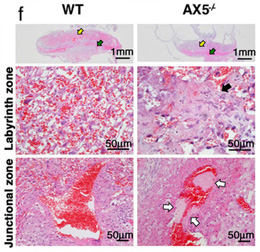Research Abstract
母体のアネキシンA5の欠失は胎盤の血小板血栓形成および胎児喪失の可能性を高める
Loss of Maternal Annexin A5 Increases the Likelihood of Placental Platelet Thrombosis and Foetal Loss
2012年11月9日 Scientific Reports 2 : 827 doi: 10.1038/srep00827

抗リン脂質症候群は血栓症や不育症のリスク上昇に関連している。アネキシンA5(Anxa5)は自己抗原候補の1つである。しかし、内因性Anxa5が正常妊娠の過程で、胎児喪失を防御するかどうかはわかっていない。我々は、Anxa5ノックアウトマウス(Anxa5-KO)で、産子数および胎子体重が有意に低下することを見いだした。これらの変化は、母マウスだけがAnxa5-KOの場合にも起こった。胎盤には少量のフィブリンの沈着が脱落膜組織に観察されたが、野生型とAnxa5-KOマウス間に発現量の顕著な差はなかった。ところが、血小板マーカーであるインテグリンβ3/CD61に対する免疫反応は、Anxa5-KO母マウスに認められた動脈管血栓内にのみ示された。妊娠Anxa5-KOマウスに抗凝固剤へパリンを皮下投与すると、妊娠損失が有意に低下し、母体のAnxa5が完全な胎盤循環の維持に重要であることが示唆された。したがって、母体のAnxa5の存在は、胎盤循環における血栓症のリスクを最小にし、胎児喪失のリスクを低下させる。
植木 紘史 1*, 水品 智菜1, Titaree Laoharatchatathanin1, 寺島 涼太1, 西村 育宏1, Duangjai Rieanrakwong1†, 米澤 智洋1, 久留主 志朗1, 長谷川 喜久2, Bent Brachvogel3, Ernst Pöschl4 & 汾陽 光盛1
- 北里大学獣医畜産学部 獣医生理学研究室
- 北里大学獣医畜産学部 実験動物学研究室
- ケルン大学 CMMC(独)
- イーストアングリア大学(英)
*現所属: 東京大学大学院 医学系研究科・医学部 免疫学講座
†現所属: マハナコーン工科大学 獣医生理学研究室
Antiphospholipid syndrome is associated with an increased risk of thrombosis and pregnancy loss. Annexin A5 (Anxa5) is a candidate autoantigen. It is not known, however, whether endogenous Anxa5 prevents foetal loss during normal pregnancy. We found significant reductions in litter size and foetal weight in Anxa5-null mice (Anxa5-KO). These changes occurred even when only the mother was Anxa5-KO. A small amount of placental fibrin deposition was observed in the decidual tissues, but did not noticeably differ between wild-type and Anxa5-KO mice. However, immunoreactivity for integrin beta 3/CD61, a platelet marker, was demonstrated within thrombi in the arterial canals only in Anxa5-KO mothers. Subcutaneous administration of the anticoagulant heparin to pregnant Anxa5-KO mice significantly reduced pregnancy loss, suggesting that maternal Anxa5 is crucial for maintaining intact placental circulation. Hence, the presence of maternal Anxa5 minimises the risk of thrombosis in the placental circulation and reduces the risk of foetal loss.

